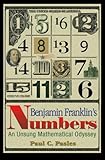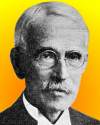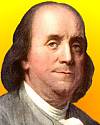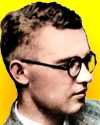 | TODAY IN SCIENCE HISTORY
NEWSLETTER - 17 JANUARY |
 On 17 Jan 1706, Benjamin Franklin was born, American printer, inventor and scientist. Today's Science Store pick is: Benjamin Franklin's Numbers: An Unsung Mathematical Odyssey, by Paul C. Pasles. So how might the success of the American Revolution depend on magic squares? This is answered in this equation-free book that views the life and times of Benjamin Franklin through a mathematical lens. Franklin's hugely popular Poor Richard's Almanac featured such things as population estimates and a host of mathematical digression. Although you may think you know about this well-known scientist, no doubt this will be a new aspect to you. It is available New from $15.49. Used from $6.23. (As of time of writing.). On 17 Jan 1706, Benjamin Franklin was born, American printer, inventor and scientist. Today's Science Store pick is: Benjamin Franklin's Numbers: An Unsung Mathematical Odyssey, by Paul C. Pasles. So how might the success of the American Revolution depend on magic squares? This is answered in this equation-free book that views the life and times of Benjamin Franklin through a mathematical lens. Franklin's hugely popular Poor Richard's Almanac featured such things as population estimates and a host of mathematical digression. Although you may think you know about this well-known scientist, no doubt this will be a new aspect to you. It is available New from $15.49. Used from $6.23. (As of time of writing.). | | For picks from earlier newsletters, see the Today in Science History Science Store home page. | |
 | Science can never be a closed book. It is like a tree, ever growing, ever reaching new heights. Occasionally the lower branches, no longer giving nourishment to the tree, slough off. We should not be ashamed to change our methods; rather we should be ashamed never to do so. - Charles V. Chapin, American physician, public health officer and epidemiologist (born 17 Jan 1856).  |
 | It seems to me, that if statesmen had a little more arithmetic, or were accustomed to calculation, wars would be much less frequent. - Benjamin Franklin, American statesman, scientist, inventor, diplomat, author, printer and publisher (born 17 Jan 1706).  |
 | We do not draw conclusions with our eyes, but with our reasoning powers, and if the whole of the rest of living nature proclaims with one accord from all sides the evolution of the world of organisms, we cannot assume that the process stopped short of Man. But it follows also that the factors which brought about the development of Man from his Simian ancestry must be the same as those which have brought about the whole of evolution. - August Weismann, German biologist (born 17 Jan 1834).  |
| Before you look at today's web page, see if you can answer some of these questions about the events that happened on this day. Some of the names are very familiar. Others will likely stump you. Tickle your curiosity with these questions, then check your answers on today's web page. |
 | On 17 Jan 1706, Benjamin Franklin was born, whose varied accomplishments include being an printer and publisher, author, inventor and scientist, and diplomat. He become widely known in European scientific circles for his reports of electrical experiments and theories. He invented a stove, still being manufactured, to give more warmth than open fireplaces.
 What was Franklin's invention to improve his aging eyesight? |
 | Clyde W. Tombaugh (1906-1997) was an American astronomer who in 1930 made the only discovery of its kind in the twentieth century. Tombaugh was 24 years of age when he made this discovery at Lowell Observatory in Flagstaff, Ariz.
 What was Tombaugh's most famous discovery? |
 | Richard Lower (1631-1691) was an English physician and physiologist who made the first direct transfusion of blood from one animal to the veins of another (1665). This idea of injecting blood into a living animal, and of doing this not by syringe or bladder, but from one animal to another, was first mentioned by Lower in a letter to Robert Boyle of Jun 1664.
 What animals did he use in his blood transfusion investigation? |
| On 17 Jan of a certain year, for the first time, full energy was released by the first synchrotron which was installed at the Radiation Laboratory, University of California, Berkeley. It was invented by Edwin Mattison of the same university, and would accelerate electrons by virtue of their negative charges, using a betatron-type magnet that weighed about 8 tons.
 In which decade did this synchroton first operate at full energy? |
 | On 17 Jan 1871, a U.S. patent was issued for an “endless wire rope way” subsequently used for the the first cable car public transport in the world powered using moving cables under the street.
 In which city did Hallidie build the first such public transport? |
When you have your answers ready to all the questions above, you'll find all the information to check them, and more, on the January 17 web page of Today in Science History. Or, try this link first for just the brief answers.
Fast answers for the previous newsletter for January 16: Rwanda • decade including the year 1953 • Robert Jemison Van de Graaff • Saturn • Ernest Shackleton • samples from a comet. |
 If you enjoy this newsletter, the website, or wish to offer encouragement or ideas, please send feedback by using your mail reader Reply button. If you enjoy this newsletter, the website, or wish to offer encouragement or ideas, please send feedback by using your mail reader Reply button.
Your click on a StumbleUpon, Google+ or Facebook social button on the site webpages is also a welcome sign of appreciation. Thank you for using them. |
To find citations for quotations go to the corresponding webpage by clicking on the “quotes” balloon icon. Sources for the thumbnails appear on today's webpage with the corresponding item.
� This newsletter is copyright 2014 by todayinsci.com. Please respect the Webmaster's wishes and do not put copies online of the Newsletter � or any Today in Science History webpage. (If you already have done so, please remove them. Thank you.) Offline use in education is encouraged such as a printout on a bulletin board, or projected for classroom viewing. Online, descriptive links to our pages are welcomed, as these will provide a reader with the most recent revisions, additions and/or corrections of a webpage. For any other copyright questions, please contact the Webmaster by using your mail reader Reply button. |
--
If you do not want to receive any more newsletters,
Unsubscribe To update your preferences and to unsubscribe visit
this link 






 What was Franklin's invention to improve his aging eyesight?
What was Franklin's invention to improve his aging eyesight? 
 What was Tombaugh's most famous discovery?
What was Tombaugh's most famous discovery? 
 What animals did he use in his blood transfusion investigation?
What animals did he use in his blood transfusion investigation?  In which decade did this synchroton first operate at full energy?
In which decade did this synchroton first operate at full energy? 
 In which city did Hallidie build the first such public transport?
In which city did Hallidie build the first such public transport?  If you enjoy this newsletter, the website, or wish to offer encouragement or ideas, please send feedback by using your mail reader Reply button.
If you enjoy this newsletter, the website, or wish to offer encouragement or ideas, please send feedback by using your mail reader Reply button. 

Δεν υπάρχουν σχόλια:
Δημοσίευση σχολίου